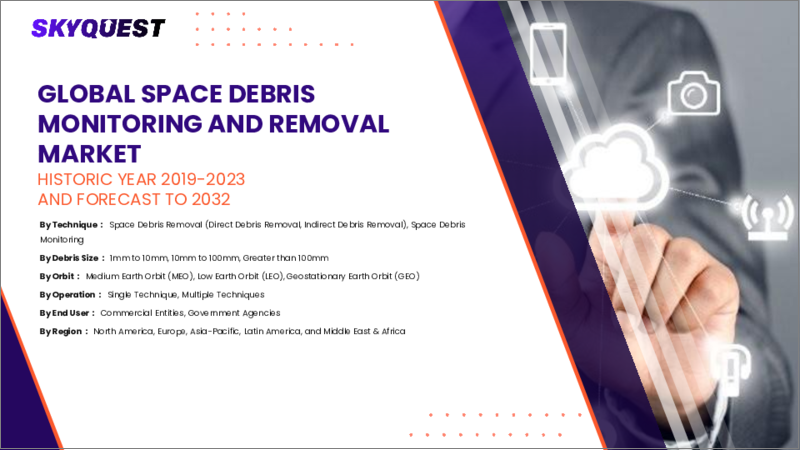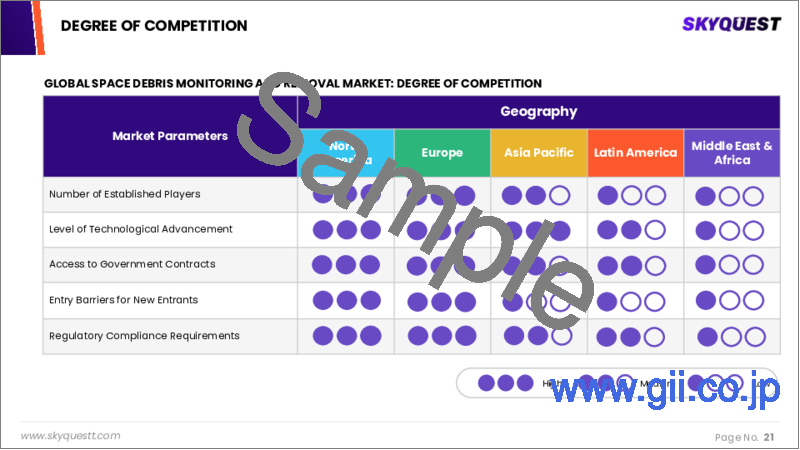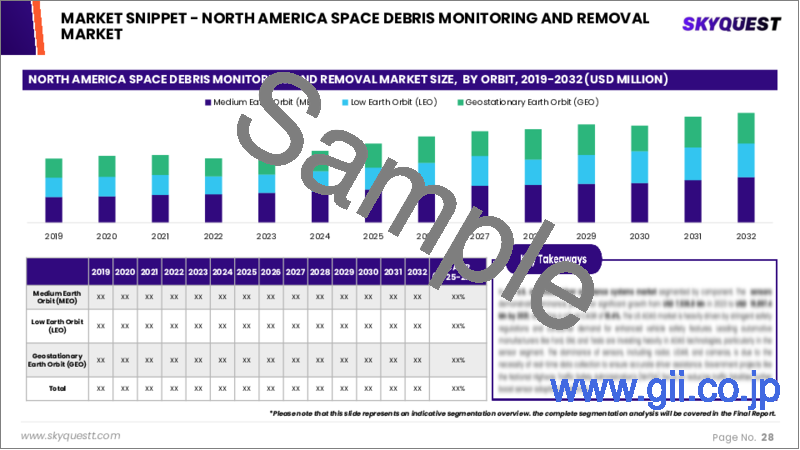|
|
市場調査レポート
商品コード
1610805
スペースデブリ監視および除去の市場規模、シェア、成長分析、デブリサイズ範囲別、軌道タイプ別、用途別、地域別 - 産業予測、2024年~2031年Space Debris Monitoring and Removal Market Size, Share, Growth Analysis, By Debris Size Range, By Orbit Type, By Application, By Region - Industry Forecast 2024-2031 |
||||||
|
|||||||
| スペースデブリ監視および除去の市場規模、シェア、成長分析、デブリサイズ範囲別、軌道タイプ別、用途別、地域別 - 産業予測、2024年~2031年 |
|
出版日: 2024年12月08日
発行: SkyQuest
ページ情報: 英文 183 Pages
納期: 3~5営業日
|
全表示
- 概要
- 目次
スペースデブリ監視および除去の世界市場規模は、2022年に10億1,000万米ドルと評価され、2023年の10億8,000万米ドルから2031年には17億5,000万米ドルに成長し、予測期間(2024-2031年)のCAGRは7.15%で成長する見通しです。
スペースデブリの蓄積の増大は、運用衛星や将来の宇宙開発に重大なリスクをもたらすため、世界各国政府はデブリ軽減を目的とした政策枠組みの導入を促しています。地球周回軌道が廃衛星、ロケットの残骸、その他の物体で乱雑になる中、効果的なモニタリングと除去戦略は、宇宙の持続可能性を維持するために不可欠になっています。高い開発コストと規制遵守が障壁となっている一方で、宇宙観光の急増と技術の進歩は、スペースデブリ・モニタリング市場に大きな機会をもたらしています。さらに、現在の衛星の多くは20~25年間も運用されるなど老朽化が進んでいるため、デブリ問題はさらに深刻化しており、この増大する課題に対処するための効果的なモニタリング、除去、使用終了ソリューションへの需要が高まっています。
目次
イントロダクション
- 調査の目的
- 調査範囲
- 定義
調査手法
- 情報調達
- 二次データと一次データの方法
- 市場規模予測
- 市場の前提条件と制限
エグゼクティブサマリー
- 世界市場の見通し
- 供給と需要の動向分析
- セグメント別機会分析
市場力学と見通し
- 市場概要
- 市場規模
- 市場力学
- 促進要因と機会
- 抑制要因と課題
- ポーター分析と影響
- 競争企業間の敵対関係
- 代替品の脅威
- 買い手の交渉力
- 新規参入業者の脅威
- 供給企業の交渉力
主な市場の考察
- 重要成功要因
- 競合の程度
- 主な投資機会
- 市場エコシステム
- 市場の魅力指数(2023年)
- PESTEL分析
- マクロ経済指標
- バリューチェーン分析
- 価格分析
- 技術の進歩
- 規制情勢
- ケーススタディ
スペースデブリ監視および除去の市場規模:デブリサイズ範囲別& CAGR(2024-2031)
- デブリサイズ1mm~1cm
- デブリサイズ1cm~10cm
- 10cm以上
スペースデブリ監視および除去の市場規模:軌道タイプ別& CAGR(2024-2031)
- 低軌道(LEO)
- 中軌道(MEO)
- 静止地球軌道(GEO)
スペースデブリ監視および除去の市場規模:用途別& CAGR(2024-2031)
- スペースデブリ監視
- スペースデブリ除去
スペースデブリ監視および除去の市場規模:エンドユーザー別& CAGR(2024-2031)
- 商業
- 防衛
スペースデブリ監視および除去の市場規模:地域別& CAGR(2024-2031)
- 北米
- 米国
- カナダ
- 欧州
- 英国
- ドイツ
- スペイン
- フランス
- イタリア
- その他欧州地域
- アジア太平洋地域
- 中国
- インド
- 日本
- 韓国
- その他アジア太平洋地域
- ラテンアメリカ
- ブラジル
- その他ラテンアメリカ地域
- 中東・アフリカ
- GCC諸国
- 南アフリカ
- その他中東・アフリカ
競合情報
- 上位5社の比較
- 主要企業の市場ポジショニング(2023年)
- 主な市場企業が採用した戦略
- 市場の最近の動向
- 企業の市場シェア分析(2023年)
- 主要企業の企業プロファイル
- 会社概要
- 製品ポートフォリオ分析
- セグメント別シェア分析
- 収益の前年比比較(2021-2023)
主要企業プロファイル
- Airbus S.A.S
- Astroscale
- ClearSpace
- Electro Optic Systems
- Lockheed Martin Corporation
- Northrop Grumman Corporation
- Orbit Guardians
- Obruta
- Share my space
- Voyager Space Holdings Inc.
結論と推奨事項
Global Space Debris Monitoring and Removal Market size was valued at USD 1.01 Billion in 2022 and is poised to grow from USD 1.08 Billion in 2023 to USD 1.75 Billion by 2031, growing at a CAGR of 7.15% in the forecast period (2024-2031).
The increasing accumulation of space debris poses significant risks to operational satellites and future space endeavors, prompting governments worldwide to implement policy frameworks aimed at debris mitigation. With Earth's orbits cluttered with defunct satellites, rocket remnants, and other objects, effective monitoring and removal strategies are becoming essential for maintaining space sustainability. While the high development costs and regulatory compliance represent barriers to market growth, the surge in space tourism and advancements in technology present substantial opportunities for the space debris monitoring market. Furthermore, the aging of current satellites, many of which remain in service for 20-25 years, exacerbates the debris issue, intensifying the demand for effective monitoring, removal, and end-of-life solutions to address this growing challenge.
Top-down and bottom-up approaches were used to estimate and validate the size of the Global Space Debris Monitoring And Removal market and to estimate the size of various other dependent submarkets. The research methodology used to estimate the market size includes the following details: The key players in the market were identified through secondary research, and their market shares in the respective regions were determined through primary and secondary research. This entire procedure includes the study of the annual and financial reports of the top market players and extensive interviews for key insights from industry leaders such as CEOs, VPs, directors, and marketing executives. All percentage shares split, and breakdowns were determined using secondary sources and verified through Primary sources. All possible parameters that affect the markets covered in this research study have been accounted for, viewed in extensive detail, verified through primary research, and analyzed to get the final quantitative and qualitative data.
Global Space Debris Monitoring And Removal Market Segmental Analysis
Global Space Debris Monitoring and Removal Market is segmented by Debris Size Range, by Orbit Type, by Application, by End Use and by Region. Based on Debris Size Range, the market is segmented into 1mm to 1cm Debris Size, 1cm to 10cm Debris Size, Greater than 10 Cm. Based on Orbit Type, the market is segmented into Low Earth Orbit (LEO), Medium-Earth Orbit (MEO), Geostationary Earth Orbit (GEO). Based on Application, the market is segmented into Space Debris Monitoring, Space Debris Removal. Based on End Use, the market is segmented into Commercial, Defense. Based on region, the market is segmented into North America, Europe, Asia Pacific, Latin America and Middle East & and Africa.
Driver of the Global Space Debris Monitoring And Removal Market
A primary catalyst for the Global Space Debris Monitoring and Removal market is the rising frequency of space activities, including satellite deployments and various space missions. This escalation in activity leads to an anticipated surge in space debris, necessitating the development of efficient monitoring and remediation solutions. Ensuring that future space operations are both safe and sustainable is imperative in light of these growing concerns. Consequently, the demand for robust systems to track and eliminate space debris will continue to grow, as industry stakeholders recognize the importance of safeguarding the space environment for ongoing and future endeavors.
Restraints in the Global Space Debris Monitoring And Removal Market
The Global Space Debris Monitoring and Removal market faces significant constraints primarily due to limited resources and funding. The expenses involved in monitoring and removing space debris are substantial, encompassing the development and implementation of monitoring systems such as ground-based radars and space-based sensors. Additionally, the costs related to designing, launching, and maneuvering spacecraft for effective debris removal-whether through active or passive methods-further exacerbate the financial burden. Consequently, these high costs pose a substantial challenge in achieving widespread monitoring and removal efforts, hindering progress in mitigating the risks associated with space debris.
Market Trends of the Global Space Debris Monitoring And Removal Market
The Global Space Debris Monitoring and Removal market is witnessing a significant trend driven by advancements in tracking and monitoring technologies. The emergence of round-based radars, space-based sensors, and highly sensitive optical telescopes enables the identification and cataloging of smaller debris particles, thereby enhancing situational awareness in Earth's orbit. This comprehensive tracking capability allows stakeholders to assess collision risks more accurately and facilitates strategic planning for debris removal initiatives. As the volume of space debris continues to rise, investments in these advanced technologies are expected to accelerate, propelling market growth and fostering international collaborations for mitigating the risks associated with space debris.
Table of Contents
Introduction
- Objectives of the Study
- Scope of the Report
- Definitions
Research Methodology
- Information Procurement
- Secondary & Primary Data Methods
- Market Size Estimation
- Market Assumptions & Limitations
Executive Summary
- Global Market Outlook
- Supply & Demand Trend Analysis
- Segmental Opportunity Analysis
Market Dynamics & Outlook
- Market Overview
- Market Size
- Market Dynamics
- Driver & Opportunities
- Restraints & Challenges
- Porters Analysis & Impact
- Competitive rivalry
- Threat of substitute
- Bargaining power of buyers
- Threat of new entrants
- Bargaining power of suppliers
Key Market Insights
- Key Success Factors
- Degree of Competition
- Top Investment Pockets
- Market Ecosystem
- Market Attractiveness Index, 2023
- PESTEL Analysis
- Macro-Economic Indicators
- Value Chain Analysis
- Pricing Analysis
- Technological Advancement
- Regulatory Landscape
- Case Studies
Global Space Debris Monitoring and Removal Market Size by Debris Size Range & CAGR (2024-2031)
- 1mm to 1cm Debris Size
- 1cm to 10cm Debris Size
- Greater than 10 Cm
Global Space Debris Monitoring and Removal Market Size by Orbit Type & CAGR (2024-2031)
- Low Earth Orbit (LEO)
- Medium-Earth Orbit (MEO)
- Geostationary Earth Orbit (GEO)
Global Space Debris Monitoring and Removal Market Size by Application & CAGR (2024-2031)
- Space Debris Monitoring
- Space Debris Removal
Global Space Debris Monitoring and Removal Market Size by End User & CAGR (2024-2031)
- Commercial
- Defense
Global Space Debris Monitoring and Removal Market Size by Region & CAGR (2024-2031)
- North America, (Debris Size Range, by Orbit Type, by Application, by End Use)
- US
- Canada
- Europe, (Debris Size Range, by Orbit Type, by Application, by End Use)
- UK
- Germany
- Spain
- France
- Italy
- Rest of Europe
- Asia-Pacific, (Debris Size Range, by Orbit Type, by Application, by End Use)
- China
- India
- Japan
- South Korea
- Rest of Asia Pacific
- Latin America, (Debris Size Range, by Orbit Type, by Application, by End Use)
- Brazil
- Rest of Latin America
- Middle East & Africa, (Debris Size Range, by Orbit Type, by Application, by End Use)
- GCC Countries
- South Africa
- Rest of Middle East & Africa
Competitive Intelligence
- Top 5 Player Comparison
- Market Positioning of Key Players, 2023
- Strategies Adopted by Key Market Players
- Recent Developments in the Market
- Company Market Share Analysis, 2023
- Company Profiles of All Key Players
- Company Details
- Product Portfolio Analysis
- Company's Segmental Share Analysis
- Revenue Y-O-Y Comparison (2021-2023)
Key Company Profiles
- Airbus S.A.S
- Company Overview
- Business Segment Overview
- Financial Updates
- Key Developments
- Astroscale
- Company Overview
- Business Segment Overview
- Financial Updates
- Key Developments
- ClearSpace
- Company Overview
- Business Segment Overview
- Financial Updates
- Key Developments
- Electro Optic Systems
- Company Overview
- Business Segment Overview
- Financial Updates
- Key Developments
- Lockheed Martin Corporation
- Company Overview
- Business Segment Overview
- Financial Updates
- Key Developments
- Northrop Grumman Corporation
- Company Overview
- Business Segment Overview
- Financial Updates
- Key Developments
- Orbit Guardians
- Company Overview
- Business Segment Overview
- Financial Updates
- Key Developments
- Obruta
- Company Overview
- Business Segment Overview
- Financial Updates
- Key Developments
- Share my space
- Company Overview
- Business Segment Overview
- Financial Updates
- Key Developments
- Voyager Space Holdings Inc.
- Company Overview
- Business Segment Overview
- Financial Updates
- Key Developments






